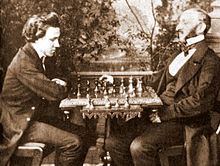- Morphy number
-
 Paul Morphy
Paul Morphy
The Morphy number is a measure of how closely a chess player is connected to Paul Morphy (1837–1884) by way of playing chess games.[1] People who played a chess game with Morphy have a Morphy number of 1. Players who did not play Morphy but played someone with a Morphy number of 1 have a Morphy number of 2. People who played someone with a Morphy number of 2 have a Morphy number of 3, et cetera.
The idea is similar to the Erdős number for mathematicians and the Bacon number for actors. For example, Garry Kasparov, along with most current top players, has a Morphy number of 5: Kasparov played Ratmir Kholmov (Morphy number 4), who played Mikhail Botvinnik (Morphy number 3), who played Reginald Michell (Morphy number 2), who played John Owen (Morphy number 1), who played Morphy. (Chess historian Taylor Kingston thinks that it is likely that Kasparov played an offhand game with Botvinnik, which would give him a Morphy number of 4.)[1] Kingston states that the idea of the Morphy number may have originated in a June 2000 note by Tim Krabbé, who has Morphy number 4.[2][3]
 Morphy and Löwenthal, who is getting a Morphy number of 1
Morphy and Löwenthal, who is getting a Morphy number of 1
As of September 28, 2010, Leonard Barden, Pal Benko, Arthur Bisguier, Melvin Chernev, Andrija Fuderer, Svetozar Gligorić, Dennis Horne, Borislav Ivkov, Erik Karklins, Franciscus Kuijpers, Louis Levy, Aleksandar Matanović, Fridrik Olafsson, Jonathan Penrose, Oliver Penrose, Arturo Pomar, Lothar Schmid, and Peter Swinnerton-Dyer are the only known living players with Morphy number 3.[4][5][6] Andor Lilienthal and Bent Larsen, who also had Morphy numbers of 3, died in May and September 2010, respectively.
There will probably be few new players with Morphy number 4, although there are probably many thousands of them alive. There may be millions of people with Morphy number 5. Many ordinary players have a Morphy number of 6 (or less).[2]
Contents
Morphy number of famous players
These are players who are important in making links for Morphy numbers.
Morphy number 1
Morphy is known to have played about 100 people, but all of the known links for players with Morphy number 2 go through the following five players.[1][4] Some Irish players could go through the Rev. Dr George Salmon, who played in one of Morphy's blindfold chess simultaneous exhibitions.[1]
- Adolf Anderssen
- Henry Bird
- James Mortimer
Morphy number 2
Everyone in this group played someone in the group above. Some of the most important members of this group follow.[1] Tartakower lost to Mortimer early in his chess career, which spanned beyond WW2, so allowed many younger players to gain a 3.
- Semyon Alapin
- Ossip Bernstein
- Joseph Blackburne
- Amos Burn
- Mikhail Chigorin
- Isidor Gunsberg
- David Janowski
- S. Lipschütz
Morphy number 3
Most of the masters in this group played several members of the previous group. This group includes some of the most important players for making connections to later generations. Botvinnik and Reshevsky played older masters such as Lasker and Janowski, had long careers, and played many younger players.[1] Najdorf was Tartakower's pupil and they played a number of published games together, and Najdorf played blitz right into his 80s, allowing many younger players to achieve 4. C.J.S. Purdy played Tartakower (2), enabling many Australian players to achieve 4.
- Alexander Alekhine
- Leonard Barden
- Pal Benko
- Arthur Bisguier
- Efim Bogolyubov
- Fedor Bogatyrchuk[3]
- Mikhail Botvinnik
- David Bronstein
- José Raúl Capablanca
- Martin Christoffel
- Arnold Denker
- Marcel Duchamp
- Oldřich Duras
- Erich Eliskases
Morphy number 4
As of 2010[update] many of these players are still alive; a few (such as Short) are still active.[1]
Morphy number 5
As of 2010[update] many of the top grandmasters are in this group (along with a large number of lesser players).[1]
See also
- Comparing top chess players throughout history
- List of chess players
- Shusaku number, the equivalent of this, for the board game of Go
References
- ^ a b c d e f g Your Morphy Number is Up, by Taylor Kingston, PDF
- ^ a b Playing the Morphy Number Game, by Tim Harding, PDF
- ^ Tim Krabbé - see item #67
- ^ a b c Frederick Rhine, Fun with Morphy Numbers
- ^ Barden's comments to Tim Harding, Playing the Morphy Number Game, chesscafe.com, 2010.
- ^ Edward Winter, Chess Note 6614, June 11, 2010. Retrieved on September 15, 2010.
External links
Categories:- Chess terminology
Wikimedia Foundation. 2010.
